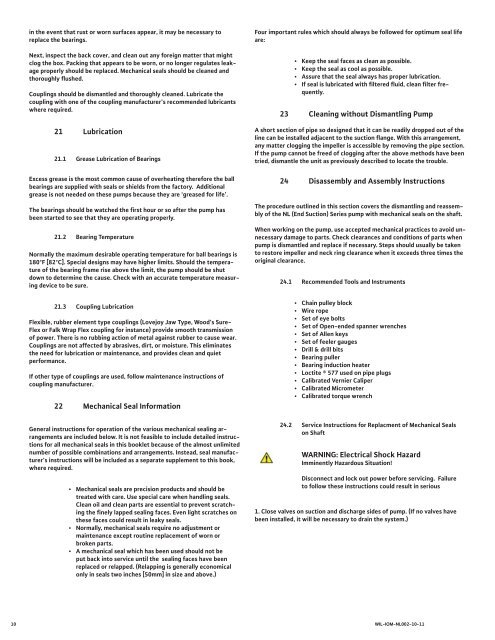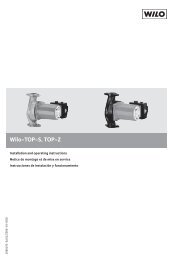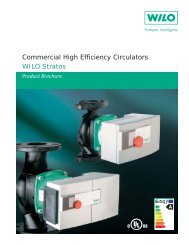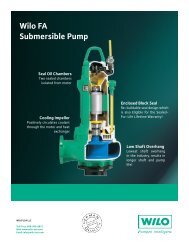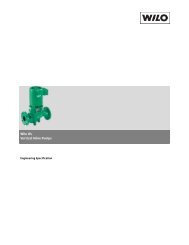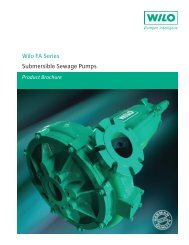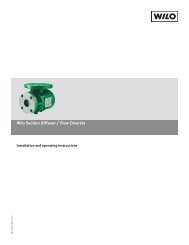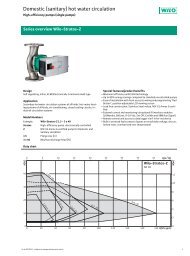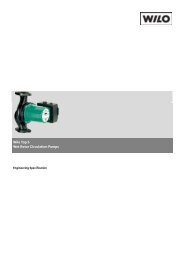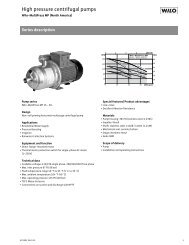Wilo NL Base Mount End Suction Pumps - Wilo Canada Inc.
Wilo NL Base Mount End Suction Pumps - Wilo Canada Inc.
Wilo NL Base Mount End Suction Pumps - Wilo Canada Inc.
Create successful ePaper yourself
Turn your PDF publications into a flip-book with our unique Google optimized e-Paper software.
in the event that rust or worn surfaces appear, it may be necessary toreplace the bearings.Next, inspect the back cover, and clean out any foreign matter that mightclog the box. Packing that appears to be worn, or no longer regulates leakageproperly should be replaced. Mechanical seals should be cleaned andthoroughly flushed.Couplings should be dismantled and thoroughly cleaned. Lubricate thecoupling with one of the coupling manufacturer’s recommended lubricantswhere required.21 Lubrication21.1 Grease Lubrication of BearingsExcess grease is the most common cause of overheating therefore the ballbearings are supplied with seals or shields from the factory. Additionalgrease is not needed on these pumps because they are ‘greased for life’.The bearings should be watched the first hour or so after the pump hasbeen started to see that they are operating properly.21.2 Bearing TemperatureNormally the maximum desirable operating temperature for ball bearings is180°F [82°C]. Special designs may have higher limits. Should the temperatureof the bearing frame rise above the limit, the pump should be shutdown to determine the cause. Check with an accurate temperature measuringdevice to be sure.21.3 Coupling LubricationFlexible, rubber element type couplings (Lovejoy Jaw Type, Wood’s Sure-Flex or Falk Wrap Flex coupling for instance) provide smooth transmissionof power. There is no rubbing action of metal against rubber to cause wear.Couplings are not affected by abrasives, dirt, or moisture. This eliminatesthe need for lubrication or maintenance, and provides clean and quietperformance.If other type of couplings are used, follow maintenance instructions ofcoupling manufacturer.22 Mechanical Seal InformationGeneral instructions for operation of the various mechanical sealing arrangementsare included below. It is not feasible to include detailed instructionsfor all mechanical seals in this booklet because of the almost unlimitednumber of possible combinations and arrangements. Instead, seal manufacturer’sinstructions will be included as a separate supplement to this book,where required.• Mechanical seals are precision products and should betreated with care. Use special care when handling seals.Clean oil and clean parts are essential to prevent scratchingthe finely lapped sealing faces. Even light scratches onthese faces could result in leaky seals.• Normally, mechanical seals require no adjustment ormaintenance except routine replacement of worn orbroken parts.• A mechanical seal which has been used should not beput back into service until the sealing faces have beenreplaced or relapped. (Relapping is generally economicalonly in seals two inches [50mm] in size and above.)Four important rules which should always be followed for optimum seal lifeare:• Keep the seal faces as clean as possible.• Keep the seal as cool as possible.• Assure that the seal always has proper lubrication.• If seal is lubricated with filtered fluid, clean filter frequently.23 Cleaning without Dismantling PumpA short section of pipe so designed that it can be readily dropped out of theline can be installed adjacent to the suction flange. With this arrangement,any matter clogging the impeller is accessible by removing the pipe section.If the pump cannot be freed of clogging after the above methods have beentried, dismantle the unit as previously described to locate the trouble.24 Disassembly and Assembly InstructionsThe procedure outlined in this section covers the dismantling and reassemblyof the <strong>NL</strong> (<strong>End</strong> <strong>Suction</strong>) Series pump with mechanical seals on the shaft.When working on the pump, use accepted mechanical practices to avoid unnecessarydamage to parts. Check clearances and conditions of parts whenpump is dismantled and replace if necessary. Steps should usually be takento restore impeller and neck ring clearance when it exceeds three times theoriginal clearance.24.1 Recommended Tools and Instruments• Chain pulley block• Wire rope• Set of eye bolts• Set of Open-ended spanner wrenches• Set of Allen keys• Set of feeler gauges• Drill & drill bits• Bearing puller• Bearing induction heater• Loctite ® 577 used on pipe plugs• Calibrated Vernier Caliper• Calibrated Micrometer• Calibrated torque wrench24.2 Service Instructions for Replacment of Mechanical Sealson ShaftWARNING: Electrical Shock HazardImminently Hazardous Situation!Disconnect and lock out power before servicing. Failureto follow these instructions could result in serious1. Close valves on suction and discharge sides of pump. (If no valves havebeen installed, it will be necessary to drain the system.)10 WIL-IOM-<strong>NL</strong>002-10-11


